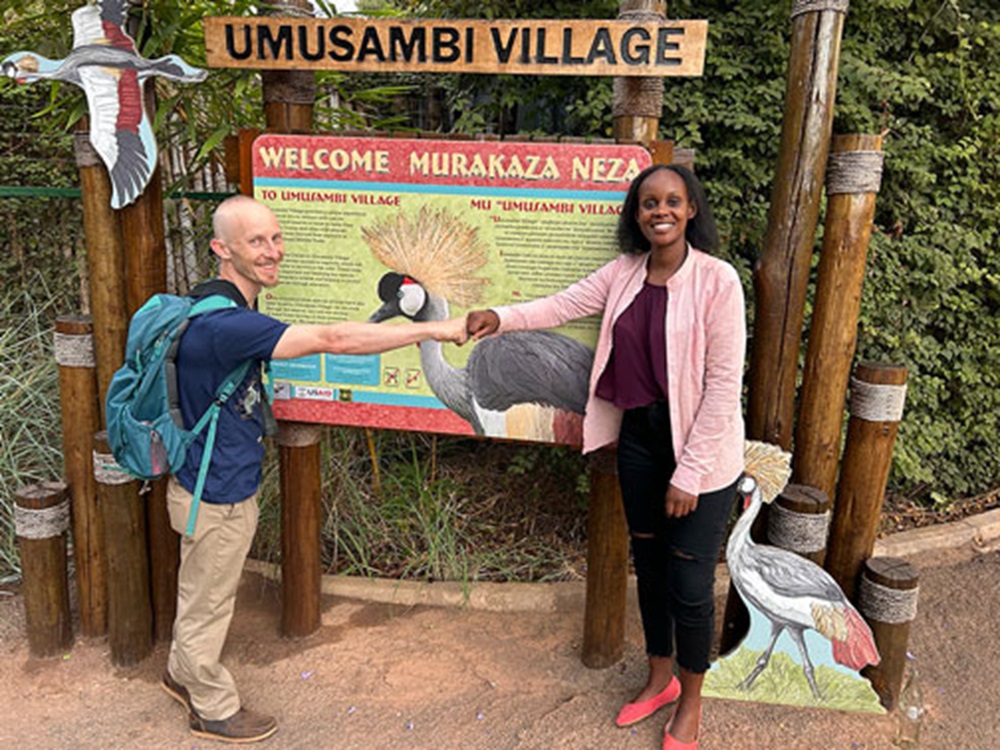
Winnie Kyamujara, the village’s head guide, said they were inspired to restore the area to conserve the majestic birds. “They were endangered, and their population was declining in the country. We thought of a place where they can reproduce and allow them to be in their natural environment,” Kyamujara told Xinhua.
About seven years ago, the grey-crowned cranes were almost driven to the edge of extinction by illegal bird hunters in Rwanda. As of 2017, there were fewer than 500 cranes of the species in the East African country.
The plight has driven conservation efforts by the Rwanda Wildlife Conservation Association, a non-governmental organization (NGO), to restore a wetland area at Umusambi village to safeguard the endangered birds, after Olivier Nsengimana, a Rwandan veterinary doctor, designed a unique conservation project to combat the illegal trade of the endangered bird species in Rwanda.

The organization started the restoration work in 2018 and brought in the birds at the end of 2019.
“We restored this place because cranes love to be in native trees. That is why we focused on restoring the place and bringing the grey-crowned cranes saved from the illegal pet trade so that they can thrive and live freely like they used to be in the wild before,” Kyamujara said.
Cranes do not like to live in captivity or any enclosure or home. The organization, however, rescued many cranes that were disabled due to their capture and transportation or because people had cut their wings to stop them from flying away.
Restoration of the place involved knowing the kinds of trees and plants that needed to be planted.
The organization marked trees that were exotic and invasive. It hired community members to help remove invasive and exotic trees. It then sourced seedlings for indigenous trees and planted more than 10,000 trees with the help of casual laborers.

“In the 2017 census, we had less than 500 cranes in the country, but by last year, we had 1,216, so the population of cranes doubled, and we are proud of that,” said Kyamujara.
She believed that the establishment of the sanctuary at the Umusambi village impacted the community and surrounding areas beyond conservation.
“We employed more than 200 people daily during restoration. Besides casual workers, we hired permanent workers. We are working here because this place was restored. It is a nice place that everyone would wish to visit,” she said.
She said besides cranes, Umusambi village sanctuary is now also home to many other bird species and wildlife.

The village has more than 130 bird species, according to her. Other wildlife, including butterflies and lizards meant to be in the wild, can be found there.
“We hope that in the years to come, Umusambi village will have more animals compared to cranes,” she said.
About 10 tourists from China have signed up for an annual pass to the village, and they are its good supporters, according to Kyamujara. “The feedback they give us is that we are doing a great job, we are making a change; they are supportive of us,” Kyamujara said.
To ensure the safety of the birds, the conservation area is fenced off with an electric fence.
Besides, guides monitor the birds every morning and evening to ensure they are healthy.
“We have a team of veterinary doctors who treat sick birds. We also have a clinic for wildlife which treats birds and small mammals,” she said, adding that the safety of the cranes is guaranteed.

The Rwanda Wildlife Conservation Association started with campaigns on various media platforms, teaching people the dangers of keeping cranes in their homes. It carries out education campaigns in schools and communities about conservation. It also hosts schools to teach students about the importance of conserving cranes.
Kyamujara said the campaign helped combat poaching of the cranes for petty trade.
Umusambi village is just one of the six places the NGO has since restored for conservation.
Kyamujara thought that the lessons learned from the Umusambi village project to save cranes could help to protect other wildlife under threat. “Many people now understand the importance of conserving the environment. But conservation requires collective efforts,” said Kyamujara.
Subscribe to view notification of our daily news
RwandaPodium © All Rights Reserved. Powered by thesublime.rw